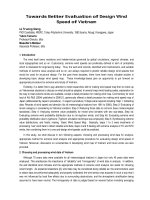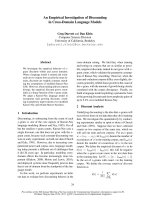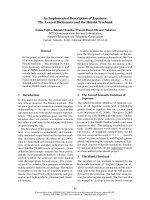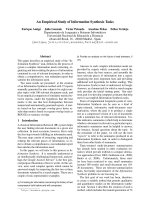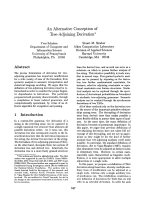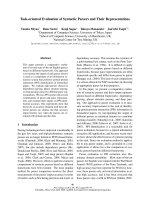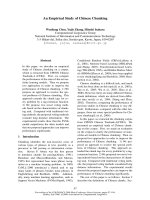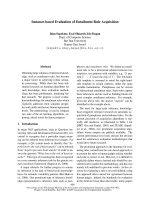Báo cáo khoa học: "An Empirical Evaluation of Probabilistic Lexicalized Tree Insertion Grammars*" potx
Bạn đang xem bản rút gọn của tài liệu. Xem và tải ngay bản đầy đủ của tài liệu tại đây (645.19 KB, 7 trang )
An Empirical Evaluation of Probabilistic Lexicalized Tree
Insertion Grammars *
Rebecca Hwa
Harvard University
Cambridge, MA 02138 USA
rebecca~eecs.harvard.edu
Abstract
We present an empirical study of the applica-
bility of Probabilistic Lexicalized Tree Inser-
tion Grammars (PLTIG), a lexicalized counter-
part to Probabilistic Context-Free Grammars
(PCFG), to problems in stochastic natural-
language processing. Comparing the perfor-
mance of PLTIGs with non-hierarchical N-gram
models and PCFGs, we show that PLTIG com-
bines the best aspects of both, with language
modeling capability comparable to N-grams,
and improved parsing performance over its non-
lexicalized counterpart. Furthermore, train-
ing of PLTIGs displays faster convergence than
PCFGs.
1
Introduction
There are many advantages to expressing a
grammar in a
lexicalized form,
where an ob-
servable word of the language is encoded in
each grammar rule. First, the lexical words
help to clarify ambiguities that cannot be re-
solved by the sentence structures alone. For
example, to correctly attach a prepositional
phrase, it is often necessary to consider the lex-
ical relationships between the head word of the
prepositional phrase and those of the phrases
it might modify. Second, lexicalizing the gram-
mar rules increases computational efficiency be-
cause those rules that do not contain any ob-
served words can be pruned away immediately.
The Lexicalized Tree Insertion Grammar for-
malism (LTIG) has been proposed as a way
to lexicalize context-free grammars (Schabes
* This material is based upon work supported by the Na-
tional Science Foundation under Grant No. IR19712068.
We thank Yves Schabes and Stuart Shieber for their
guidance; Joshua Goodman for his PCFG code; Lillian
Lee and the three anonymous reviewers for their com-
ments on the paper.
and Waters, 1994). We now apply a prob-
abilistic variant of this formalism, Probabilis-
tic Tree Insertion Grammars (PLTIGs), to nat-
ural language processing problems of stochas-
tic parsing and language modeling. This pa-
per presents two sets of experiments, compar-
ing PLTIGs with non-lexicalized Probabilistic
Context-Free Grammars (PCFGs) (Pereira and
Schabes, 1992) and non-hierarchical N-gram
models that use the right branching bracketing
heuristics (period attaches high) as their pars-
ing strategy. We show that PLTIGs can be in-
duced from partially bracketed data, and that
the resulting trained grammars can parse un-
seen sentences and estimate the likelihood of
their occurrences in the language. The experi-
ments are run on two corpora: the Air Travel
Information System (ATIS) corpus and a sub-
set of the Wall Street Journal TreeBank cor-
pus. The results show that the lexicalized na-
ture of the formalism helps our induced PLTIGs
to converge faster and provide a better language
model than PCFGs while maintaining compara-
ble parsing qualities. Although N-gram models
still slightly out-perform PLTIGs on language
modeling, they lack high level structures needed
for parsing. Therefore, PLTIGs have combined
the best of two worlds: the language modeling
capability of N-grams and the parse quality of
context-free grammars.
The rest of the paper is organized as fol-
lows: first, we present an overview of the PLTIG
formalism; then we describe the experimental
setup; next, we interpret and discuss the results
of the experiments; finally, we outline future di-
rections of the research.
2 PLTIG and Related Work
The inspiration for the PLTIG formalism stems
from the desire to lexicalize a context-free gram-
557
mar. There are three ways in which one might
do so. First, one can modify the tree struc-
tures so that all context-free productions con-
tain lexical items. Greibach normal form pro-
vides a well-known example of such a lexical-
ized context-free formalism. This method is
not practical because altering the structures of
the grammar damages the linguistic informa-
tion stored in the original grammar (Schabes
and Waters, 1994). Second, one might prop-
agate lexical information upward through the
productions. Examples of formalisms using this
approach include the work of Magerman (1995),
Charniak (1997), Collins (1997), and Good-
man (1997). A more linguistically motivated
approach is to expand the domain of produc-
tions downward to incorporate more tree struc-
tures. The Lexicalized Tree-Adjoining Gram-
mar (LTAG) formalism (Schabes et al., 1988),
(Schabes, 1990) , although not context-free, is
the most well-known instance in this category.
PLTIGs belong to this third category and gen-
erate only context-free languages.
LTAGs (and LTIGs) are tree-rewriting sys-
tems, consisting of a set of elementary trees
combined by tree operations. We distinguish
two types of trees in the set of elementary trees:
the
initial trees
and the
auxiliary trees.
Unlike
full parse trees but reminiscent of the produc-
tions of a context-free grammar, both types of
trees may have nonterminal leaf nodes. Aux-
iliary trees have, in addition, a distinguished
nonterminal leaf node, labeled with the same
nonterminal as the root node of the tree, called
the
foot
node. Two types of operations are used
to construct
derived trees,
or parse trees: sub-
stitution and adjunction. An initial tree can
be
substituted
into the nonterminal leaf node of
another tree in a way similar to the substitu-
tion of nonterminals in the production rules of
CFGs. An auxiliary tree is inserted into another
tree through the adjunction operation, which
splices the auxiliary tree into the target tree at
a node labeled with the same nonterminal as
the root and foot of the auxiliary tree. By us-
ing a tree representation, LTAGs extend the do-
main of locality of a grammatical primitive, so
that they capture both lexical features and hi-
erarchical structure. Moreover, the adjunction
operation elegantly models intuitive linguistic
concepts such as long distance dependencies be-
tween words. Unlike the N-gram model, which
only offers dependencies between neighboring
words, these trees can model the interaction of
structurally related words that occur far apart.
Like LTAGs, LTIGs are tree-rewriting sys-
tems, but they differ from LTAGs in their gener-
ative power. LTAGs can generate some strictly
context-sensitive languages. They do so by us-
ing
wrapping
auxiliary trees, which allow non-
empty frontier nodes (i.e., leaf nodes whose la-
bels are not the empty terminal symbol) on both
sides of the foot node. A wrapping auxiliary
tree makes the formalism context-sensitive be-
cause it coordinates the string to the left of its
foot with the string to the right of its foot while
allowing a third string to be inserted into the
foot. Just as the ability to recursively center-
embed moves the required parsing time from
O(n)
for regular grammars to O(n 3) for context-
free grammars, so the ability to wrap auxiliary
trees moves the required parsing time further,
to
O(n 8)
for tree-adjoining grammars 1. This
level of complexity is far too computationally
expensive for current technologies. The com-
plexity of LTAGs can be moderated by elimi-
nating just the wrapping auxiliary trees. LTIGs
prevent wrapping by restricting auxiliary tree
structures to be in one of two forms: the
left
auxiliary tree,
whose non-empty frontier nodes
are all to the left of the foot node; or the
right
auxiliary tree,
whose non-empty frontier nodes
are all to the right of the foot node. Auxil-
iary trees of different types cannot adjoin into
each other if the adjunction would result in a
wrapping auxiliary tree. The resulting system
is strongly equivalent to CFGs, yet is fully lex-
icalized and still O(n 3) parsable, as shown by
Schabes and Waters (1994).
Furthermore, LTIGs can be parameterized to
form probabilistic models (Schabes and Waters,
1993). Informally speaking, a parameter is as-
sociated with each possible adjunction or sub-
stitution operation between a tree and a node.
For instance, suppose there are V left auxiliary
trees that might adjoin into node r/. Then there
are V q- 1 parameters associated with node r/
1The best theoretical upper bound on time complex-
ity for the recognition of Tree Adjoining Languages is
O(M(n2)),
where
M(k)
is the time needed to multiply
two k x k boolean matrices.(Rajasekaran and Yooseph,
1995)
558
Elem~ntwy ~ ~:
t l~t t~ptl 1
£ X, ~td I
t~rd 2 twordn
X word 2 X
word n
* $
Figure h A set of elementary LTIG trees that
represent a bigram grammar. The arrows indi-
cate adjunction sites.
that describe the distribution of the likelihood
of any left auxiliary tree adjoining into node ~/.
(We need one extra parameter for the case of
no left adjunction.) A similar set of parame-
ters is constructed for the right adjunction and
substitution distributions.
3 Experiments
In the following experiments we show that
PLTIGs of varying sizes and configurations can
be induced by processing a large training cor-
pus, and that the trained PLTIGs can provide
parses on unseen test data of comparable qual-
ity to the parses produced by PCFGs. More-
over, we show that PLTIGs have significantly
lower entropy values than PCFGs, suggesting
that they make better language models. We
describe the induction process of the PLTIGs
in Section 3.1. Two corpora of very different
nature are used for training and testing. The
first set of experiments uses the Air Travel In-
formation System (ATIS) corpus. Section 3.2
presents the complete results of this set of ex-
periments. To determine if PLTIGs can scale
up well, we have also begun another study that
uses a larger and more complex corpus, the Wall
Street Journal TreeBank corpus. The initial re-
sults are discussed in Section 3.3. To reduce the
effect of the data sparsity problem, we back off
from lexical words to using the part of speech
tags as the anchoring lexical items in all the
experiments. Moreover, we use the deleted-
interpolation smoothing technique for the N-
gram models and PLTIGs. PCFGs do not re-
quire smoothing in these experiments.
3.1 Grammar
Induction
The technique used to induce a grammar is a
subtractive process. Starting from a universal
grammar (i.e., one that can generate any string
made up of the alphabet set), the parameters
Example
sentence:
The cat chases the
mouse
Corresponding derivation tree:
tinit .~dJ.
tthe
.~dj.
teat
~dj.
tchase s
~dj.
ttht ,,,1~t.
adj.
tmouse
Figure 2: An example sentence. Because each
tree is right adjoined to the tree anchored with
the neighboring word in the sentence, the only
structure is right branching.
are iteratively refined until the grammar gen-
erates, hopefully, all and only the sentences in
the target language, for which the training data
provides an adequate sampling. In the case of
a PCFG, the initial grammar production rule
set contains all possible rules in Chomsky Nor-
mal Form constructed by the nonterminal and
terminal symbols. The initial parameters asso-
ciated with each rule are randomly generated
subject to an admissibility constraint. As long
as all the rules have a non-zero probability, any
string has a non-zero chance of being generated.
To train the grammar, we follow the Inside-
Outside re-estimation algorithm described by
Lari and Young (1990). The Inside-Outside re-
estimation algorithm can also be extended to
train PLTIGs. The equations calculating the
inside and outside probabilities for PLTIGs can
be found in Hwa (1998).
As with PCFGs, the initial grammar must be
able to generate any string. A simple PLTIG
that fits the requirement is one that simulates
a bigram model. It is represented by a tree set
that contains a right auxiliary tree for each lex-
ical item as depicted in Figure 1. Each tree has
one adjunction site into which other right auxil-
iary trees can adjoin. The tree set has only one
initial tree, which is anchored by an empty lex-
ical item. The initial tree represents the start
of the sentence. Any string can be constructed
by right adjoining the words together in order.
Training the parameters of this grammar yields
the same result as a bigram model: the param-
eters reflect close correlations between words
559
Ktemem~ ~ Sits:
t~t tl ~ 1 a word= ~rdl uv'~¢ m
5i -_ /\
-/\
/\
-/\
~X~ X. X X X, X X, X
_sj _SIR_ " _51 __iSJR_
word I
word x
wo~ 1 wo~ X
Figure 3: An LTIG elementary tree set that al-
low both left and right adjunctions.
that are frequently seen together, but the model
cannot provide any high-level linguistic struc-
ture. (See example in Figure 2.)
Example sentence:
The cat chases the mouse
Corresponding derivation tree:
tinit
.~dj.
re,chases
~
ltca~ ~r,~rtottme
l~l'the ~'l,the
Figure 4: With both left and right adjunctions
possible, the sentences can be parsed in a more
linguistically plausible way
To generate non-linear structures, we need to
allow adjunction in both left and right direc-
tions. The expanded LTIG tree set includes a
left auxiliary tree representation as well as right
for each lexical item. Moreover, we must mod-
ify the topology of the auxiliary trees so that
adjunction in both directions can occur. We in-
sert an intermediary node between the root and
the lexical word. At this internal node, at most
one adjunction of each direction may take place.
The introduction of this node is necessary be-
cause the definition of the formalism disallows
right adjunction into the root node of a left aux-
iliary tree and vice versa. For the sake of unifor-
mity, we shall disallow adjunction into the root
nodes of the auxiliary trees from now on. Figure
3 shows an LTIG that allows at most one left
and one right adjunction for each elementary
tree. This enhanced LTIG can produce hierar-
chical structures that the bigram model could
not (See Figure 4.)
It is, however, still too limiting to allow
only one adjunction from each direction. Many
560
words often require more than one modifier. For
example, a transitive verb such as "give" takes
at least two adjunctions: a direct object noun
phrase, an indirect object noun phrase, and pos-
sibly other adverbial modifiers. To create more
adjunct/on sites for each word, we introduce yet
more intermediary nodes between the root and
the lexical word. Our empirical studies show
that each lexicalized auxiliary tree requires at
least 3 adjunction sites to parse all the sentences
in the corpora. Figure 5(a) and (b) show two
examples of auxiliary trees with 3 adjunction
sites. The number of parameters in a PLTIG
is dependent on the number of adjunction sites
just as the size of a PCFG is dependent on the
number of nonterminals. For a language with
V vocabulary items, the number of parameters
for the type of PLTIGs used in this paper is
2(V+I)+2V(K)(V+I),
where K is the number
of adjunction sites per tree. The first term of
the equation is the number of parameters con-
tributed by the initial tree, which always has
two adjunction sites in our experiments. The
second term is the contribution from the aux-
iliary trees. There are 2V auxiliary trees, each
tree has K adjunction sites; and V + 1 param-
eters describe the distribution of adjunction at
each site. The number of parameters of a PCFG
with M nonterminals is
M 3 + MV.
For the ex-
periments, we try to choose values of K and M
for the PLTIGs and PCFGs such that
2(Y + 1) +
2Y(g)(Y +
1) ~ M 3 +
MY
3.2 ATIS
To reproduce the results of PCFGs reported by
Pereira and Schabes, we use the ATIS corpus
for our first experiment. This corpus contains
577 sentences with 32 part-of-speech tags. To
ensure statistical significance, we generate ten
random train-test splits on the corpus. Each
set randomly partitions the corpus into three
sections according to the following distribution:
80% training, 10% held-out, and 10% testing.
This gives us, on average, 406 training sen-
tences, 83 testing sentences, and 88 sentences
for held-out testing. The results reported here
are the averages of ten runs.
We have trained three types of PLTIGs, vary-
ing the number of left and right adjunction sites.
The L2R1 version has two left adjunction sites
and one right adjunction site; L1R2 has one
tlw°rd n
X
x x.
word n
re
word n
X
x. ×
L\
word n
(a)
tlwo;,d n
X
word
n
rrwordn
X
5xt
word n
(b)
tlw°rd n
X
word n
~'word n
X
x.
sx\
word nl
(c)
]
t
11
No. of ~
I I
40 45
r~O
• ,.IF~- m
"t.2Rl"
%2R2"
"PCFG1 S"
"PCFG2~'
I
Figure 6: Average convergence rates of the
training process for 3 PLTIGs and 2 PCFGs.
Figure 5: Prototypical auxiliary trees for three
PLTIGs: (a) L1R2, (b) L2R1, and (c) L2R2.
left adjunction site and two right adjunction
sites; L2R2 has two of each. The prototypi-
cal auxiliary trees for these three grammars are
shown in Figure 5. At the end of every train-
ing iteration, the updated grammars are used
to parse sentences in the held-out test sets D,
and the new language modeling scores (by mea-
suring the cross-entropy estimates f/(D, L2R1),
f/(D, L1R2), and//(D, L2R2)) are calculated.
The rate of improvement of the language model-
ing scores determines convergence. The PLTIGs
are compared with two PCFGs: one with
15-nonterminals, as Pereira and Schabes have
done, and one with 20-nonterminals, which has
comparable number of parameters to L2R2, the
larger PLTIG.
In Figure 6 we plot the average iterative
improvements of the training process for each
grammar. All training processes of the PLTIGs
converge much faster (both in numbers of itera-
tions and in real time) than those of the PCFGs,
even when the PCFG has fewer parameters to
estimate, as shown in Table 1. From Figure 6,
we see that both PCFGs take many more iter-
ations to converge and that the cross-entropy
value they converge on is much higher than the
PLTIGs.
During the testing phase, the trained gram-
mars are used to produce bracketed constituents
on unmarked sentences from the testing sets
T. We use the crossing bracket metric to
evaluate the parsing quality of each gram-
mar. We also measure the cross-entropy es-
timates
[-I(T, L2R1), f-I(T, L1R2),H(T, L2R2),
f-I(T, PCFG:5),
and
fI(T, PCFG2o)
to deter-
mine the quality of the language model. For
a baseline comparison, we consider bigram and
trigram models with simple right branching
bracketing heuristics. Our findings are summa-
rized in Table 1.
The three types of PLTIGs generate roughly
the same number of bracketed constituent errors
as that of the trained PCFGs, but they achieve
a much lower entropy score. While the average
entropy value of the trigram model is the low-
est, there is no statistical significance between it
and any of the three PLTIGs. The relative sta-
tistical significance between the various types of
models is presented in Table 2. In any case, the
slight language modeling advantage of the tri-
gram model is offset by its inability to handle
parsing.
Our ATIS results agree with the findings of
Pereira and Schabes that concluded that the
performances of the PCFGs do not seem to de-
pend heavily on the number of parameters once
a certain threshold is crossed. Even though
PCFG2o
has about as many number of param-
eters as the larger PLTIG (L2R2), its language
modeling score is still significantly worse than
that of any of the PLTIGs.
561
I[ Bigram/Trigram PCFG 15
Number of parameters 1088 / 34880 3855
-
45
Iterations to convergence
Real-time convergence (min) - 62
[-I(T, Grammar)
2.88
/
2.71 3.81
Crossing bracket (on T) 66.78 93.46
PCFG201L1R21L2R1 I L2R2
8640 6402 6402 8514
45 19 17 24
142 8 7 14
3.42 2.87 2.85 2.78
93.41 93.07 93.28 94.51
Table 1: Summary results for ATIS. The machine used to measure real-time is an HP 9000/859.
Number of
parameters
Bigram/Trigram
2400 / 115296
PCFG 15
4095
PCFG 20
8960
PCFG
23[ LIR2
I
L2R1 I L2R2
13271
Iterations to - 80 60 70
convergence
Real-time con- - 143 252 511
vergence (hr)
.f-I(T, Grammar
3.39/3.20 4.31 4.27 4.13
Crossing 49.44 56.41 78.82 79.30
bracket (T)
14210 14210 18914
28 30 28
38 41 60
3.58 3.56 3.59
80.08 82.43 80.832
Table 3: Summary results of the training phase for WSJ
PLTIGs II better
bigram better -
trigram better - better
I[ PCFGs PLTIGs bigram
Table 2: Summary of pair-wise t-test for all
grammars. If "better" appears at cell
(i,j),
then
the model in row i has an entropy value lower
than that of the model in column j in a statis-
tically significant way. The symbol "-" denotes
that the difference of scores between the models
bears no statistical significance.
3.3 WSJ
Because the sentences in ATIS are short with
simple and similar structures, the difference in
performance between the formalisms may not
be as apparent. For the second experiment,
we use the Wall Street Journal (WSJ) corpus,
whose sentences are longer and have more var-
ied and complex structures. We use sections
02 to 09 of the WSJ corpus for training, sec-
tion 00 for held-out data D, and section 23 for
test T. We consider sentences of length 40 or
less. There are 13242 training sentences, 1780
sentences for the held-out data, and 2245 sen-
tences in the test. The vocabulary set con-
sists of the 48 part-of-speech tags. We compare
three variants of PCFGs (15 nonterminals, 20
nonterminals, and 23 nonterminals) with three
variants of PLTIGs (L1R2, L2R1, L2R2). A
PCFG with 23 nonterminals is included because
its size approximates that of the two smaller
PLTIGs. We did not generate random train-
test splits for the WSJ corpus because it is large
enough to provide adequate sampling. Table
3 presents our findings. From Table 3, we see
several similarities to the results from the ATIS
corpus. All three variants of the PLTIG formal-
ism have converged at a faster rate and have
far better language modeling scores than any of
the PCFGs. Differing from the previous experi-
ment, the PLTIGs produce slightly better cross-
ing bracket rates than the PCFGs on the more
complex WSJ corpus. At least 20 nonterminals
are needed for a PCFG to perform in league
with the PLTIGs. Although the PCFGs have
fewer parameters, the rate seems to be indiffer-
ent to the size of the grammars after a thresh-
old has been reached. While upping the number
of nonterminal symbols from 15 to 20 led to a
22.4% gain, the improvement from
PCFG2o
to
PCFG23
is only 0.5%. Similarly for PLTIGs,
L2R2 performs worse than L2R1 even though it
has more parameters. The baseline comparison
for this experiment results in more extreme out-
comes. The right branching heuristic receives a
562
crossing bracket rate of 49.44%, worse than even
that of
PCFG15.
However, the N-gram models
have better cross-entropy measurements than
PCFGs and PLTIGs; bigram has a score of 3.39
bits per word, and trigram has a score of 3.20
bits per word. Because the lexical relationship
modeled by the PLTIGs presented in this pa-
per is limited to those between two words, their
scores are close to that of the bigram model.
4 Conclusion and Future Work
In this paper, we have presented the results
of two empirical experiments using Probabilis-
tic Lexicalized Tree Insertion Grammars. Com-
paring PLTIGs with PCFGs and N-grams, our
studies show that a lexicalized tree represen-
tation drastically improves the quality of lan-
guage modeling of a context-free grammar to
the level of N-grams without degrading the
parsing accuracy. In the future, we hope to
continue to improve on the quality of parsing
and language modeling by making more use
of the lexical information. For example, cur-
rently, the initial untrained PLTIGs consist of
elementary trees that have uniform configura-
tions (i.e., every auxiliary tree has the same
number of adjunction sites) to mirror the CNF
representation of PCFGs. We hypothesize that
a grammar consisting of a set of elementary
trees whose number of adjunction sites depend
on their lexical anchors would make a closer ap-
proximation to the "true" grammar. We also
hope to apply PLTIGs to natural language tasks
that may benefit from a good language model,
such as speech recognition, machine translation,
message understanding, and keyword and topic
spotting.
References
Eugene Charniak. 1997. Statistical parsing
with a context-free grammar and word statis-
tics. In
Proceedings of the AAAI,
pages 598-
603, Providence, RI. AAAI Press/MIT Press.
Michael Collins. 1997. Three generative, lexi-
calised models for statistical parsing. In Pro-
ceedings of the 35th Annual Meeting of the
ACL,
pages 16-23, Madrid, Spain.
Joshua Goodman. 1997. Probabilistic fea-
ture grammars. In
Proceedings of the Inter-
national Workshop on Parsing Technologies
1997.
Rebecca Hwa. 1998. An empirical evaluation of
probabilistic lexicalized tree insertion gram-
mars. Technical Report 06-98, Harvard Uni-
versity. Full Version.
K. Lari and S.J. Young. 1990. The estima-
tion of stochastic context-free grammars us-
ing the inside-outside algorithm. Computer
Speech and Language,
4:35-56.
David Magerman. 1995. Statistical decision-
models for parsing. In
Proceedings of the 33rd
Annual Meeting of the A CL,
pages 276-283,
Cambridge, MA.
Fernando Pereira and Yves Schabes. 1992.
Inside-Outside reestimation from partially
bracketed corpora. In
Proceedings of the 30th
Annual Meeting of the ACL,
pages 128-135,
Newark, Delaware.
S. Rajasekaran and S. Yooseph. 1995. Tal
recognition in
O(M(n2))
time. In
Proceedings
of the 33rd Annual Meeting of the A CL,
pages
166-173, Cambridge, MA.
Y. Schabes and R. Waters. 1993. Stochastic
lexicalized context-free grammar. In
Proceed-
ings of the Third International Workshop on
Parsing Technologies,
pages 257-266.
Y. Schabes and R. Waters. 1994. Tree insertion
grammar: A cubic-time parsable formalism
that lexicalizes context-free grammar without
changing the tree produced. Technical Re-
port TR-94-13, Mitsubishi Electric Research
Laboratories.
Y. Schabes, A. Abeille, and A. K. Joshi. 1988.
Parsing strategies with 'lexicalized' gram-
mars: Application to tree adjoining gram-
mars. In
Proceedings of the 1Pth Interna-
tional Conference on Computational Linguis-
tics (COLING '88),
August.
Yves Schabes. 1990.
Mathematical and Com-
putational Aspects of Lexicalized Grammars.
Ph.D. thesis, University of Pennsylvania, Au-
gust.
563

